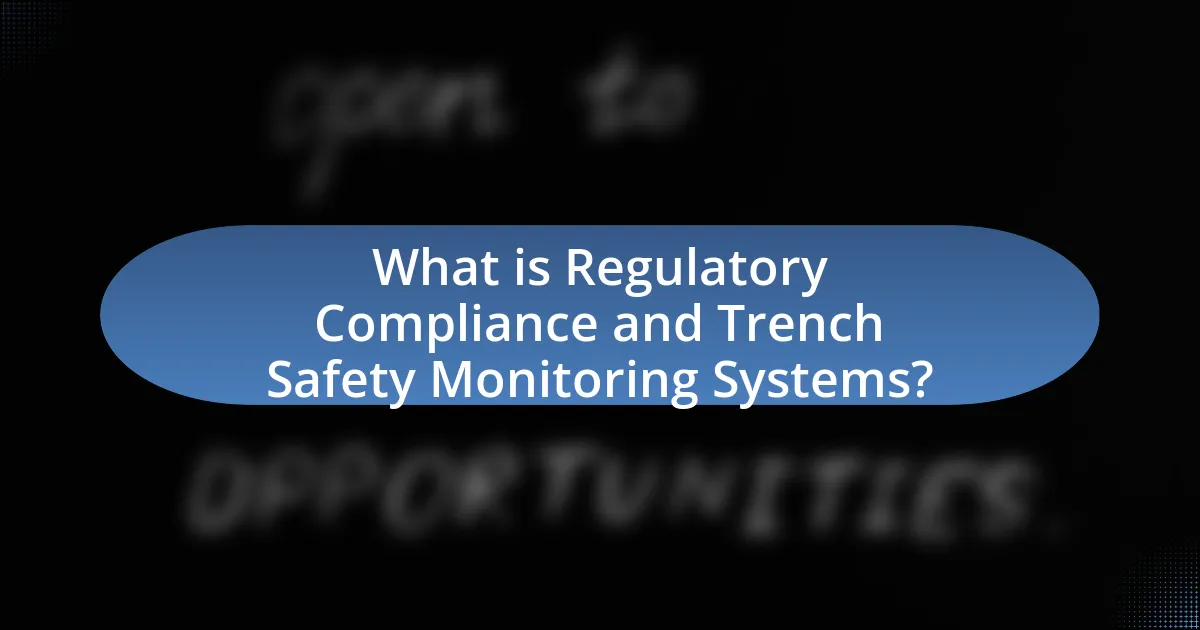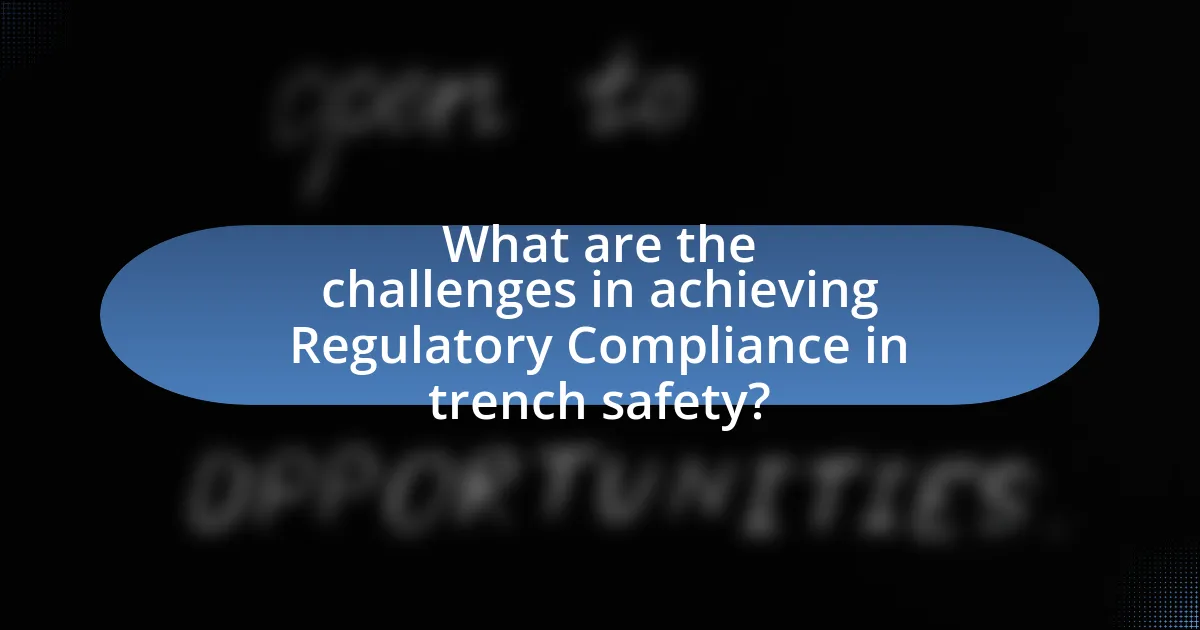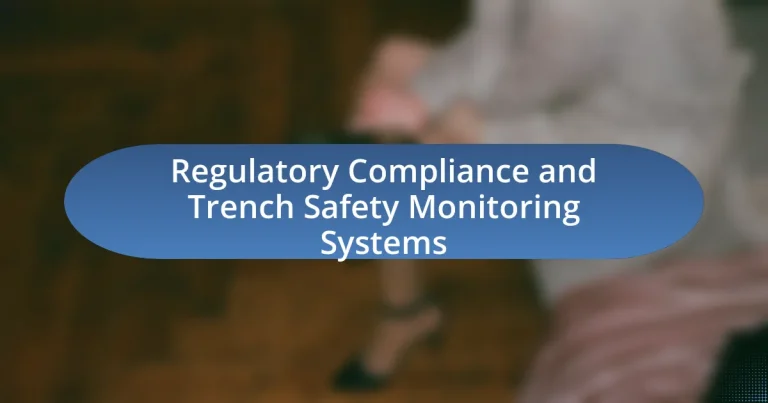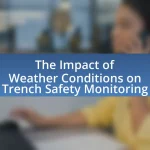Regulatory compliance in trench safety monitoring systems is essential for ensuring adherence to safety laws and regulations that protect workers during excavation operations. This article outlines the significance of regulatory compliance, detailing how trench safety monitoring systems provide real-time data on soil stability and potential hazards, thereby facilitating compliance with Occupational Safety and Health Administration (OSHA) standards. Key regulations governing trench safety, the interaction between compliance and monitoring systems, and the technologies used to enhance safety are discussed, along with best practices for implementation and the challenges organizations face in maintaining compliance. The article emphasizes the importance of training, technology, and continuous monitoring in fostering a culture of safety and reducing the risk of accidents in trenching operations.

What is Regulatory Compliance and Trench Safety Monitoring Systems?
Regulatory compliance refers to the adherence to laws, regulations, guidelines, and specifications relevant to an organization’s operations, ensuring that they meet legal and safety standards. Trench safety monitoring systems are specialized tools and technologies designed to ensure the safety of workers in trenching operations by continuously monitoring conditions such as soil stability, water accumulation, and potential hazards. These systems help prevent accidents and injuries, which are critical given that trench-related incidents account for a significant percentage of construction fatalities, as reported by the Occupational Safety and Health Administration (OSHA).
How do Regulatory Compliance and Trench Safety Monitoring Systems interact?
Regulatory compliance and trench safety monitoring systems interact by ensuring that excavation activities adhere to safety standards mandated by regulations. Trench safety monitoring systems provide real-time data on trench conditions, such as soil stability and potential hazards, which helps organizations comply with Occupational Safety and Health Administration (OSHA) regulations. For instance, OSHA requires that trenches deeper than five feet be protected against cave-ins, and monitoring systems can alert workers to unsafe conditions, thereby facilitating compliance with these safety requirements. This interaction ultimately enhances worker safety and reduces the risk of accidents in trenching operations.
What are the key regulations governing trench safety?
The key regulations governing trench safety include the Occupational Safety and Health Administration (OSHA) standards, specifically 29 CFR Part 1926 Subpart P, which outlines requirements for excavation and trenching operations. These regulations mandate protective systems for trenches deeper than five feet, including sloping, shoring, or shielding to prevent cave-ins. Additionally, the regulations require that a competent person conduct inspections of the trench site before work begins and as conditions change, ensuring compliance with safety measures. OSHA’s guidelines are based on extensive research and historical data indicating that proper trench safety practices significantly reduce the risk of accidents and fatalities in excavation work.
How do monitoring systems ensure compliance with these regulations?
Monitoring systems ensure compliance with regulations by continuously collecting and analyzing data related to safety parameters and operational practices. These systems utilize sensors and software to monitor conditions such as soil stability, water levels, and worker safety in real-time, enabling immediate detection of potential hazards. For instance, the Occupational Safety and Health Administration (OSHA) mandates specific safety measures for trenching operations, and monitoring systems can provide documented evidence of adherence to these requirements through automated reporting and alerts. This data-driven approach not only helps in maintaining compliance but also facilitates proactive risk management, thereby reducing the likelihood of accidents and regulatory violations.
Why is Regulatory Compliance important in trench safety?
Regulatory compliance is crucial in trench safety because it establishes mandatory safety standards that protect workers from hazards associated with trenching operations. Compliance with regulations, such as those set by the Occupational Safety and Health Administration (OSHA), ensures that proper safety measures, like trench shoring and protective systems, are implemented to prevent collapses, which can lead to serious injuries or fatalities. For instance, OSHA reports indicate that trench collapses account for approximately 20% of worker fatalities in excavation-related incidents, underscoring the importance of adhering to safety regulations to mitigate these risks effectively.
What are the potential consequences of non-compliance?
The potential consequences of non-compliance with regulatory standards in trench safety monitoring systems include severe financial penalties, legal liabilities, and increased risk of accidents. Non-compliance can lead to fines that vary based on jurisdiction, with some penalties reaching thousands of dollars per violation. Additionally, organizations may face lawsuits from injured parties, resulting in costly settlements or judgments. Furthermore, non-compliance increases the likelihood of workplace accidents, which can lead to injuries or fatalities, thereby damaging the organization’s reputation and leading to further regulatory scrutiny. According to the Occupational Safety and Health Administration (OSHA), non-compliance with safety regulations can result in citations that not only impose financial burdens but also require immediate corrective actions, further disrupting operations.
How does compliance enhance worker safety?
Compliance enhances worker safety by ensuring adherence to established safety regulations and standards, which are designed to minimize risks and hazards in the workplace. For instance, compliance with Occupational Safety and Health Administration (OSHA) regulations mandates regular safety training, proper equipment usage, and hazard assessments, significantly reducing the likelihood of accidents and injuries. Studies have shown that workplaces with high compliance rates experience up to 50% fewer workplace injuries, demonstrating the effectiveness of regulatory frameworks in promoting a safer working environment.
What are the components of Trench Safety Monitoring Systems?
The components of Trench Safety Monitoring Systems include sensors, data loggers, alarms, and software for data analysis. Sensors are used to detect soil movement, water levels, and atmospheric conditions, providing real-time data on trench stability. Data loggers collect and store this information for analysis, while alarms alert personnel to any unsafe conditions. Software facilitates the interpretation of data, enabling proactive safety measures. These components work together to ensure compliance with safety regulations and to minimize risks associated with trench work.
What technologies are used in trench safety monitoring?
Technologies used in trench safety monitoring include ground-penetrating radar (GPR), vibration sensors, and real-time monitoring systems. Ground-penetrating radar helps detect subsurface conditions and potential hazards, while vibration sensors monitor ground stability and detect shifts that may indicate a collapse. Real-time monitoring systems integrate various sensors to provide continuous data on trench conditions, ensuring compliance with safety regulations and enhancing worker safety. These technologies collectively contribute to reducing accidents and improving safety standards in trench operations.
How do these technologies contribute to safety and compliance?
Technologies in trench safety monitoring systems enhance safety and compliance by providing real-time data on environmental conditions and structural integrity. These systems utilize sensors to monitor factors such as soil stability, water levels, and atmospheric conditions, allowing for immediate alerts when unsafe conditions arise. For instance, the use of pressure sensors can detect shifts in soil that may indicate a potential collapse, enabling timely intervention. Compliance with regulations, such as those set by the Occupational Safety and Health Administration (OSHA), is facilitated through automated reporting features that document safety checks and incidents, ensuring that organizations meet legal requirements. This integration of technology not only minimizes risks but also fosters a culture of safety, as evidenced by a reduction in workplace accidents in environments utilizing these monitoring systems.
How can organizations implement effective Trench Safety Monitoring Systems?
Organizations can implement effective Trench Safety Monitoring Systems by integrating real-time monitoring technologies, establishing clear safety protocols, and conducting regular training for personnel. Real-time monitoring technologies, such as sensors for soil stability and water levels, provide immediate data that can prevent accidents. Clear safety protocols, aligned with OSHA regulations, ensure that all workers understand the risks and necessary precautions. Regular training sessions reinforce these protocols and keep safety practices top-of-mind. According to OSHA, proper trench safety measures can reduce the risk of fatalities and injuries, highlighting the importance of these systems in maintaining compliance and ensuring worker safety.
What steps should be taken to assess trench safety needs?
To assess trench safety needs, conduct a thorough site evaluation, which includes identifying potential hazards, reviewing soil conditions, and ensuring compliance with OSHA regulations. The evaluation should involve inspecting the trench for signs of instability, such as water accumulation or loose soil, and assessing the surrounding environment for risks like nearby traffic or overhead utilities. According to OSHA standards, trenches deeper than five feet require protective systems unless the excavation is made in stable rock. This regulatory framework emphasizes the importance of adhering to safety guidelines to prevent accidents and ensure worker safety.
How can organizations choose the right monitoring system?
Organizations can choose the right monitoring system by assessing their specific regulatory compliance needs and safety requirements. This involves identifying the types of data required for compliance, such as soil stability, water levels, and environmental conditions, which are critical for trench safety. Additionally, organizations should evaluate the technology’s reliability, ease of integration with existing systems, and the ability to provide real-time alerts and reporting features. For instance, systems that comply with OSHA regulations for trench safety monitoring are essential, as they ensure adherence to safety standards and reduce the risk of accidents. By focusing on these criteria, organizations can select a monitoring system that effectively meets their operational and regulatory demands.

What are the challenges in achieving Regulatory Compliance in trench safety?
Achieving regulatory compliance in trench safety faces several challenges, including the complexity of regulations, inconsistent enforcement, and the need for specialized training. The complexity arises from the multitude of federal, state, and local regulations that govern trench safety, making it difficult for organizations to ensure full compliance. Inconsistent enforcement by regulatory agencies can lead to confusion and varying standards across different jurisdictions. Additionally, the requirement for specialized training for workers and supervisors is critical, as inadequate training can result in non-compliance and increased risk of accidents. According to the Occupational Safety and Health Administration (OSHA), trench collapses are a leading cause of fatalities in the construction industry, highlighting the importance of stringent compliance measures.
What common obstacles do organizations face?
Organizations commonly face obstacles such as regulatory compliance challenges, inadequate safety monitoring systems, and insufficient training for personnel. Regulatory compliance challenges arise from the need to adhere to various laws and standards, which can be complex and constantly changing. Inadequate safety monitoring systems can lead to increased risks during operations, particularly in environments like trench work where safety is critical. Insufficient training for personnel can result in a lack of awareness regarding safety protocols and compliance requirements, further exacerbating risks. According to a report by the Occupational Safety and Health Administration (OSHA), improper training is a significant factor in workplace accidents, highlighting the importance of addressing these obstacles effectively.
How can training and education mitigate these challenges?
Training and education can mitigate challenges in regulatory compliance and trench safety monitoring systems by equipping personnel with the necessary knowledge and skills to adhere to safety regulations and effectively use monitoring technologies. Comprehensive training programs ensure that workers understand the risks associated with trench work, the importance of compliance with regulations such as OSHA standards, and the proper operation of safety monitoring systems. For instance, a study by the National Institute for Occupational Safety and Health (NIOSH) found that training significantly reduces the incidence of accidents in trenching operations, highlighting the effectiveness of education in promoting safe practices. By fostering a culture of safety through ongoing education, organizations can enhance compliance and reduce the likelihood of incidents.
What role does technology play in overcoming compliance challenges?
Technology plays a crucial role in overcoming compliance challenges by automating processes, enhancing data accuracy, and facilitating real-time monitoring. For instance, trench safety monitoring systems utilize sensors and software to ensure adherence to safety regulations, reducing human error and improving compliance reporting. According to a study by the National Institute for Occupational Safety and Health, the implementation of technology in safety monitoring has led to a 30% reduction in compliance violations in construction sites. This demonstrates that technology not only streamlines compliance efforts but also significantly enhances safety outcomes.
How can organizations stay updated with changing regulations?
Organizations can stay updated with changing regulations by implementing a systematic approach that includes subscribing to regulatory updates, engaging with industry associations, and utilizing compliance management software. Subscribing to newsletters from regulatory bodies ensures timely access to new rules and amendments, while participation in industry associations provides insights and networking opportunities that highlight emerging regulatory trends. Additionally, compliance management software can automate the tracking of regulatory changes, ensuring that organizations maintain adherence to the latest requirements. This multi-faceted strategy is essential for effective regulatory compliance in dynamic environments.
What resources are available for monitoring regulatory changes?
Resources available for monitoring regulatory changes include government websites, legal databases, compliance management software, and industry-specific associations. Government websites, such as the Federal Register in the United States, provide official updates on new regulations and amendments. Legal databases like Westlaw and LexisNexis offer comprehensive access to legal documents and regulatory changes. Compliance management software, such as ComplyAdvantage, helps organizations track and manage compliance requirements in real-time. Additionally, industry-specific associations often publish newsletters and reports that summarize relevant regulatory changes affecting their sectors. These resources collectively ensure that organizations stay informed about regulatory developments essential for maintaining compliance.
How can organizations adapt their systems to new regulations?
Organizations can adapt their systems to new regulations by implementing a structured compliance framework that includes regular audits, staff training, and technology upgrades. This approach ensures that organizations remain aligned with evolving regulatory requirements, such as those related to trench safety monitoring systems. For instance, the Occupational Safety and Health Administration (OSHA) mandates specific safety measures for trenching operations, which necessitates that organizations update their monitoring systems to comply with these standards. By integrating real-time monitoring technologies and conducting periodic reviews, organizations can effectively mitigate risks and ensure adherence to regulations.

What best practices should be followed for Trench Safety Monitoring?
Best practices for trench safety monitoring include regular inspections, proper shoring and bracing, and the use of trench boxes to prevent collapses. Regular inspections should be conducted by a competent person to identify hazards and ensure compliance with OSHA regulations, which state that trenches deeper than five feet require protective systems. Proper shoring and bracing techniques, such as using hydraulic shores or timber, help maintain trench stability. Additionally, employing trench boxes provides a safe working environment by protecting workers from cave-ins. These practices are essential for minimizing risks associated with trench work, as cave-ins can lead to serious injuries or fatalities, with the Bureau of Labor Statistics reporting that trench-related incidents account for a significant percentage of construction fatalities.
How can organizations ensure continuous monitoring and compliance?
Organizations can ensure continuous monitoring and compliance by implementing automated compliance management systems that track regulatory changes and monitor adherence in real-time. These systems utilize advanced technologies such as artificial intelligence and machine learning to analyze data, identify compliance gaps, and generate alerts for necessary actions. For instance, a study by the International Compliance Association found that organizations using automated systems experienced a 30% reduction in compliance-related incidents, demonstrating the effectiveness of technology in maintaining compliance. Regular audits and employee training further reinforce these systems, ensuring that staff are aware of compliance requirements and best practices.
What regular maintenance practices are essential for monitoring systems?
Regular maintenance practices essential for monitoring systems include routine inspections, software updates, calibration of sensors, and data integrity checks. Routine inspections ensure that all components are functioning correctly and can identify potential issues before they escalate. Software updates are crucial for maintaining security and performance, as they often include patches for vulnerabilities and enhancements. Calibration of sensors guarantees accurate readings, which is vital for compliance with safety regulations. Data integrity checks verify that the information collected is reliable and free from corruption, ensuring that monitoring systems provide accurate assessments of trench safety conditions. These practices collectively support regulatory compliance and enhance the effectiveness of trench safety monitoring systems.
How can data from monitoring systems be effectively analyzed?
Data from monitoring systems can be effectively analyzed by employing advanced data analytics techniques, including statistical analysis, machine learning algorithms, and real-time data visualization. These methods enable the identification of patterns, trends, and anomalies in the data collected from trench safety monitoring systems, which is crucial for ensuring regulatory compliance. For instance, using machine learning algorithms can enhance predictive maintenance by analyzing historical data to forecast potential failures, thereby improving safety outcomes. Additionally, real-time data visualization tools allow stakeholders to monitor conditions continuously, facilitating timely decision-making and compliance with safety regulations.
What are the key takeaways for effective trench safety management?
Key takeaways for effective trench safety management include implementing proper protective systems, conducting regular inspections, and ensuring worker training. Protective systems, such as trench boxes or shoring, are essential to prevent collapses, which account for approximately 75% of trench-related fatalities according to OSHA. Regular inspections before and during work ensure compliance with safety standards and identify potential hazards. Additionally, training workers on safe practices and emergency procedures is crucial, as studies show that well-trained workers are less likely to be involved in accidents.
How can organizations foster a culture of safety and compliance?
Organizations can foster a culture of safety and compliance by implementing comprehensive training programs and establishing clear safety protocols. Training programs educate employees on safety regulations and best practices, ensuring they understand their responsibilities. For instance, organizations that provide regular safety training have been shown to reduce workplace accidents by up to 30%, according to the National Safety Council. Additionally, establishing clear safety protocols creates a structured environment where employees know what is expected of them, promoting accountability. Regular audits and feedback mechanisms further reinforce compliance, as they allow organizations to identify areas for improvement and recognize adherence to safety standards.
What practical tips can enhance trench safety monitoring efforts?
Implementing regular inspections and utilizing technology can significantly enhance trench safety monitoring efforts. Regular inspections ensure that any potential hazards are identified and addressed promptly, reducing the risk of accidents. According to the Occupational Safety and Health Administration (OSHA), trenches deeper than five feet require protective systems, and frequent checks can help ensure compliance with these regulations. Additionally, employing technology such as trench monitoring systems, which can include sensors to detect soil movement or water accumulation, provides real-time data that can alert workers to unsafe conditions. This proactive approach not only aligns with regulatory compliance but also fosters a safer work environment.


